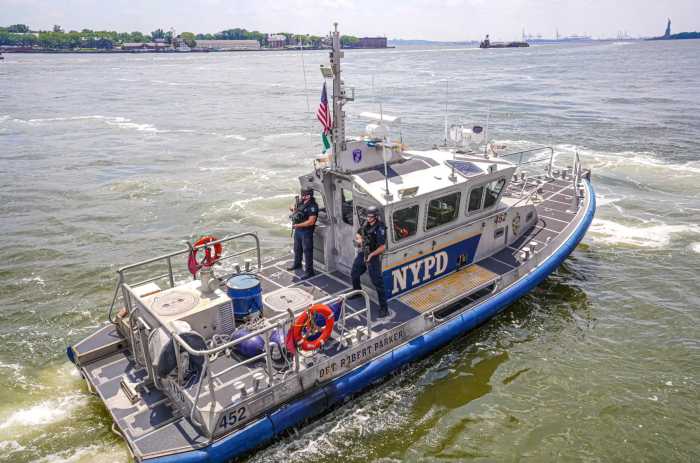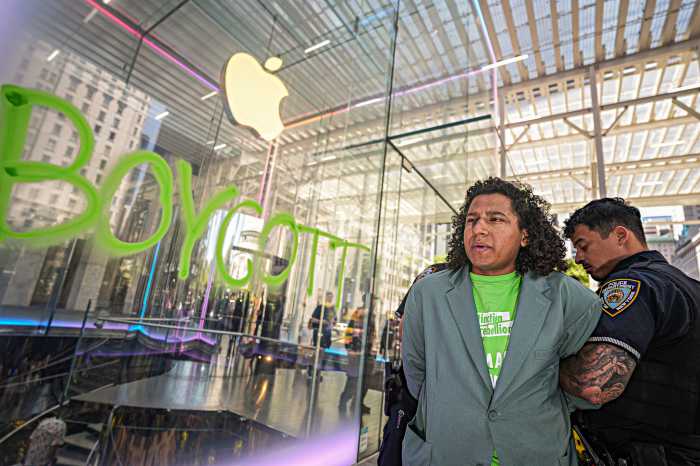BY TERESE LOEB KREUZER | New York City’s bike-share program, with 10,000 bikes and 600 stations in Manhattan, Brooklyn and Queens, is supposed to debut this month in Lower Manhattan. Once it’s up and running, the initiative will be the largest of its kind in North America, according to the NYC Department of Transportation.
But some people in Battery Park City aren’t happy with where the bikes will be placed.
The bikes will be available to anyone ages 16 or older and will be rentable by the day, the week or on an annual basis. An access card will allow users to pick up a bike in one location and return it to another using an unlocking code to remove the bikes from the docks.
Four racks holding 124 bikes will be located in Battery Park City — in the center of West Thames Street near South End Avenue, on the east side of South End Avenue near Albany Street, on the south side of Vesey Street near North End Avenue and at West and Chambers Streets.
The West Thames Street location is drawing the most fire from B.P.C. residents.
“West Thames is a real dangerous road between 2 p.m. and 4 p.m. — more so than any other time, because you have kids crossing and buses and everything else,” according to Tammy Meltzer, a member of Community Board 1’s B.P.C. Committee. “My concern is that there’s a U-turn over there, because it’s a wide location [and] there are no crosswalks.”
Percy Corcoran, a public member of the committee, echoed Meltzer’s concern. She said that the middle of the road, where the proposed rack would be placed, was designed as an emergency vehicle lane and for large vehicles such as flatbed trucks.
“It’s important to have that clear,” she said, noting as Meltzer did that many buses come around that corner. “Just put the bike rack on the South Cove cul-de-sac, where the bike path is, or on West Street,” she suggested.
In a letter addressed to Luis Sanchez, the D.O.T.’s Manhattan Borough Commissioner, the Battery Park City Authority also asked that the West Thames Street and Vesey Street bike rack locations be reconsidered, according to B.P.C.A. spokesperson Matthew Monahan.
The B.P.C.A. has also asked for the principal of Stuyvesant High School to be brought into the discussion over the proposed location on Chambers Street.
“There seems to have been an under-involvement of the broader community and the community board,” Monahan commented. “That was also expressed to Commissioner Sanchez.”
According to the D.O.T.’s website describing the bike-share program, prior to releasing a map that shows the proposed sites for the bike racks, the Department held approximately 35 public bike-share demonstrations and open houses that were offered in three languages and upwards of 50 presentations to community boards. The D.O.T. also met with other stakeholders, institutions and business improvement districts and collected nearly 10,000 station location suggestions, according to the site.
Jeff Galloway, chair of C.B. 1’s newly named Urban Planning Committee, said the D.O.T. indeed presented the bike-share program to the Downtown community board, whose membership includes residents of Battery Park City, Tribeca and the Financial District. He also said that there was a public meeting held at Pace University in the spring to discuss where the bike-share stands should be sited.
“I’m sure that what we’re seeing in Battery Park City is occurring in various neighborhoods in the five boroughs, where there may have been similar outreach to local communities and, all of a sudden, the site shows up on somebody’s doorstep and they say, ‘wait a second. I didn’t hear about this,’” Galloway observed. “Certainly, in terms of the community board itself, it was well publicized.”
He said he’d reserve judgment on the West Thames Street bike rack location until he sees the D.O.T.’s actual plans, which were to be presented to C.B. 1 on July 11.
“One of the main problems with West Thames Street is that it’s too wide,” he said. “Anything that serves to effectively narrow the street is likely to improve the traffic situation.”
George Calderaro, vice chair of C.B. 1’s B.P.C. Committee, noted that the bike racks aren’t permanent structures and can be moved if the sites initially selected turn out to create problems.
Galloway was optimistic that the D.O.T. would work things out in a way that would satisfy the community. “The experience we’ve had with them so far is that they’ve been very responsive to community input,” he said.
The bike-share program is being underwritten with a $41 million grant from Citibank. It is being run and operated by NYC Bike Share, whose parent company, Alta Bicycle Share, runs similar systems in Boston and Washington, D.C.
Bikes will be available 24 hours a day throughout the year, unless weather conditions make cycling hazardous, according to the D.O.T. website.
An annual membership in Citi Bike costs $95. Seven-day memberships can be purchased for $25 and 24-hour memberships are $9.95. The offers don’t include helmets, which cyclists are encouraged to use. Bikers can make unlimited trips within the purchased time frame, but each trip is limited to 30 minutes for seven-day and 24-hour cardholders and 45 minutes for annual members.
For more information, visit https://a841-tfpweb.nyc.gov/bikeshare.




































